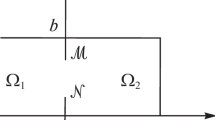Abstract
In this study, we investigate the 2D problem of diffraction of a TE-polarized electromagnetic wave in an infinite waveguide with a longitudinal partition. The mathematical formulation of this physical problem is equivalent to the boundary value problem for the Helmholtz equation with the Dirichlet-type boundary conditions and the joining conditions. The problem is solved by the partial areas method (PAM). In this method, the solution to the problem in each subdomain is sought in the form of a series with unknown coefficients, which are determined from the joining condition at the interface between the media. Using the method of integro-summatory identities, this boundary value problem is reduced to an infinite system of linear algebraic equations (ISLAE) in unknown coefficients. We have derived ISLAE corresponding to the 2D problem of diffraction in an infinite waveguide with a longitudinal diaphragm. Computer experiments have been performed. We have detected resonance effects observed when the frequency of an incident wave is close to the natural frequencies of the subdomains corresponding to the branched part of the waveguide. We have constructed the diagrams of electromagnetic fields at resonance frequencies. The electromagnetic field energies have been calculated for various wavenumbers. Proceeding from the results of computer experiments, it can be concluded that the accuracy of fulfillment of the boundary joining condition depends on the ISLAE truncation parameter. To verify the accuracy of the fulfillment of the boundary conditions, we have introduced the concept of joining mismatch. It is shown that for the incident wave frequencies close to the eigenvalues of subdomains corresponding to the branched part of the waveguide, resonance phenomena are observed.






Similar content being viewed by others
REFERENCES
R. Mittra and S. W. Lee, Analytical Techniques in the Theory of Guided Waves (Macmillan, New York, 1971).
N. B. Pleshchinskii, Models and Methods of Waveguide Electrodynamics (Kazan State Univ., Kazan, 2008) [in Russian].
Yu. G. Smirnov, Mathematical Methods of Investigating Electrodynamics Problems (Penza State Univ., Penza, 2009) [in Russian].
V. A. Neganov, E. I. Nefedov, and G. P. Yarovoi, Strip-Slot Structures of Ultra- and Extremely-High Frequencies (Nauka, Moscow, 1996) [in Russian].
V. P. Shestopalov, A. A. Kirilenko, and S. A. Masalov, Matrix Equations of Convolution Type in Diffraction Theory (Naukova Dumka, Kiev, 1984) [in Russian].
V. M. Temnov, Extended Abstract of Doctoral Dissertation in Engineering (Nizhny Novgorod, 2000).
Yu. G. Belov, Extended Abstract of Doctoral Dissertation in Engineering (Nizhny Novgorod, 2004).
M. N. Makurin and N. P. Chubinskii, J. Commun. Technol. Electron. 52 (10), 1104 (2007). https://doi.org/10.1134/S1064226907100063
G. S. Malyshev, N. A. Novoselova, and S. B. Raevskii, “The spectral method and the method to calculate the partial areas round the open dielectric waveguides,” in Proc. XXIII Int. Sci.-Tech. Conf. “Information Systems and Technologies,” Nizhny Novgorod, April 21, 2017 (Nizhny Novgorod State Tech. Univ. n.a. R.E. Alekseev, Nizhny Novgorod, 2017), p. 1318. https://elibrary.ru/item.asp?id=41201187
K. G. Savin, Yu. V. Prokopenko, and Yu. M. Poplavko, Vestn. Nats. Tekh. Univ. Ukr., No. 55, 24 (2013).
V. P. Lapin, M. B. Manuilov, and G. P. Sinyavskii, Izv. Vyssh. Uchebn. Zaved., Radiofiz., No. 2, 203 (1984).
G. V. Abgaryan and N. B. Pleshchinskii, Lobachevskii J. Math. 40 (10), 1631 (2019). https://doi.org/10.1134/S1995080219100020
G. V. Abgaryan and N. B. Pleshchinskii, Lobachevskii J. Math. 41 (7), 1325 (2020). https://doi.org/10.1134/S1995080220070033
G. V. Abgaryan, Lobachevskii J. Math. 41 (7), 1315 (2020). https://doi.org/10.1134/S1995080220070021
G. V. Abgaryan, Lobachevskii J. Math. 42 (6), 1327 (2021). https://doi.org/10.1134/S1995080221060020
G. V. Abgaryan, Lobachevskii J. Math. 43 (5), 1228 (2022). https://doi.org/10.1134/S1995080222080029
Funding
This paper has been supported by the Kazan Federal University Strategic Academic Leadership Program “PRIORITY-2030.”
Author information
Authors and Affiliations
Corresponding author
Additional information
Translated by N. Wadhwa
Rights and permissions
About this article
Cite this article
Abgaryan, G.V., Khaibullin, A.N. & Shipilo, A.E. Partial Areas Method in the Problem of Diffraction of an Electromagnetic Wave by a Longitudinal Partition in an Infinite Waveguide. Tech. Phys. 68, 1–7 (2023). https://doi.org/10.1134/S1063784223010012
Received:
Revised:
Accepted:
Published:
Issue Date:
DOI: https://doi.org/10.1134/S1063784223010012



